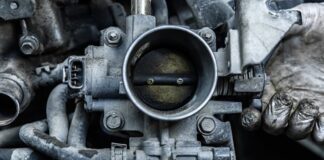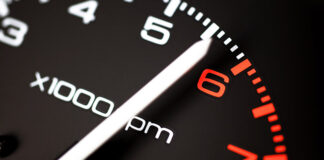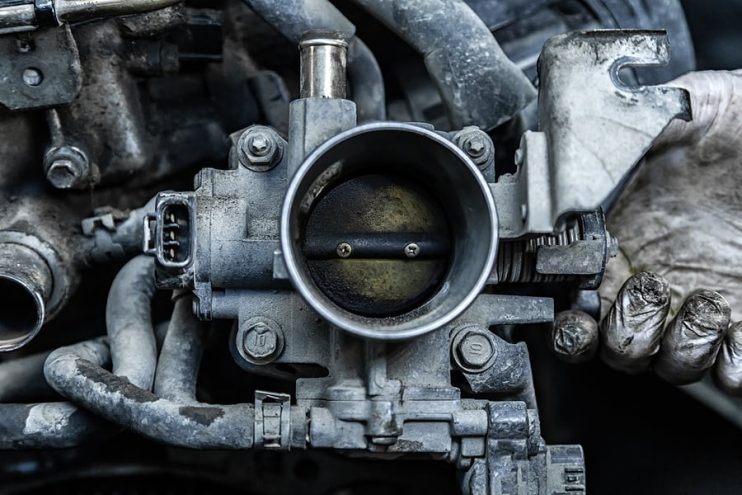Maintaining your car’s throttle body through regular cleaning is a smart preventative measure. It promotes smoother airflow with reduced turbulence, enhancing engine performance and drivability.
Cleaning the throttle body may occasionally disrupt the idle speed, as it’s regulated by the vehicle’s computer via the throttle body motor assembly.
In this guide, we’ll explain how to address high idle issues that may arise after cleaning the throttle body.
Reasons for High Idle Post-Throttle Body Cleaning
Vacuum Leakage
The mass airflow sensor precisely gauges the air entering the engine through the throttle body. A vacuum leak can occur if the throttle body allows excess air into the system, prompting the computer to add more fuel to compensate.
This requires the idle to relearn by putting the vehicle in drive and letting it idle with all accessories off for two to three minutes. The excess air can misalign with the ECU’s airflow data, potentially triggering the ‘Check Engine’ light.
A vacuum leak leads to a lean air-fuel mixture, causing erratic idling and sluggish performance. This issue is generally inexpensive and straightforward to repair, ensuring optimal engine function.
Damaged Intake Hose
Air intake hoses deliver controlled air to the combustion engine’s intake manifold. A tear in the hose can cause high idling due to air bypassing the throttle.
Such a leak creates a lean air-fuel mixture with excessive fuel, leading to engine stalling or rough idling. Replacing the damaged air intake hose is necessary to resolve rough idling.
Debris entering through holes or leaks in the air intake hose can cause various engine issues, such as poor performance or stalling, and may even lead to significant engine damage.
A whistling or sucking sound may indicate air being drawn through a hose leak.
Debris in Throttle Bore
Debris in the throttle bore disrupts the smooth movement of the plate, leading to rough idling, inconsistent acceleration, stalling, and reduced fuel efficiency. This can also cause:
1. Dirt Accumulation
Dirt buildup hinders the vehicle’s ability to draw sufficient fuel, disrupting the air and fuel flow balance and causing irregular performance.
2. Electrical Issues
Electrical problems can send incorrect signals to the car’s computer, leading to improper air-fuel mixture adjustments. This may trigger a ‘limp-home’ mode, reducing engine power regardless of pedal pressure.
Computer Recalibration
Cleaning the throttle body resets the system, requiring the car’s computer to recalibrate. This can result in excess fuel being added, causing the idle to increase temporarily.
Solutions for High Idle After Throttle Body Cleaning
Allow the Computer to Recalibrate
Be aware that the idle may initially be high until the computer recalibrates.
To recalibrate, put the vehicle in drive and let it idle with all accessories off for about two to three minutes. The car’s adaptive system adjusts to driving habits and updates its settings accordingly.
After recalibration, turn on the air conditioning with the blower set to high for three minutes.
Thoroughly Clean Throttle Body
If debris is present in the throttle body, clean both the front and rear of the bore thoroughly to resolve the issue.
Post-cleaning, the computer should recognize the throttle plate’s position and adjust the idle after some driving.
If the issue persists, the throttle sensor or motor may have been damaged during cleaning, especially if the throttle plate was repeatedly opened and closed rapidly. This requires recalibration and a professional mechanic’s inspection.
Use Diagnostic Scan Tool
A scan tool monitors the throttle position sensor and motor inputs to diagnose issues. It evaluates throttle activity to determine necessary repairs or replacements to fix high idling.
Manually Reset Electronic Throttle Control
Turn the ignition on and wait three seconds. Then, press and release the accelerator pedal five times within five seconds. Wait seven seconds, then press and hold the pedal for about 20 seconds until the check engine light stops blinking and remains on.
Adjust Throttle Position Sensor
A misaligned throttle position sensor can cause high idling. Disconnect its connector and adjust it properly to restore normal idle and acceleration.
Reprogram Throttle Body Post-Cleaning
Inspect Throttle Cable
Verify that the throttle body valve returns to its rest position.
Examine the Vacuum Hose
Check that the vacuum hose connected to the throttle body is not leaking.
Adjust Idle Air Screw
Use a flat-bladed screwdriver to adjust the idle air screw on the throttle body. Turning it in lowers the idle speed, while turning it out raises it.
Conclusion
Proper throttle body cleaning ensures your car runs smoothly. If done improperly, it can lead to high idling due to vacuum leaks, damaged intake hoses, throttle bore debris, or computer recalibration. Each issue has specific effects, some fixable at home, while others require professional attention. Address these problems promptly to avoid costly repairs.
Solutions include allowing the computer to recalibrate, thoroughly cleaning the throttle body, using a diagnostic scan tool, adjusting the throttle position sensor, throttle cable, and vacuum hose for proper positioning, ensuring throttle plates are closed, the throttle body moves freely, and the cam, crank, and distributor are correctly timed. With practice, you can clean the throttle body with minimal issues.







